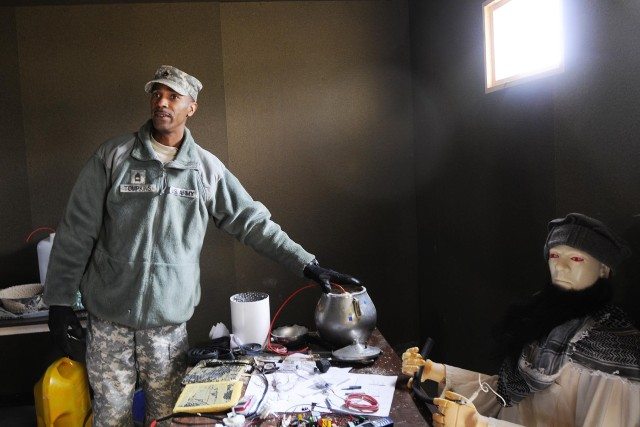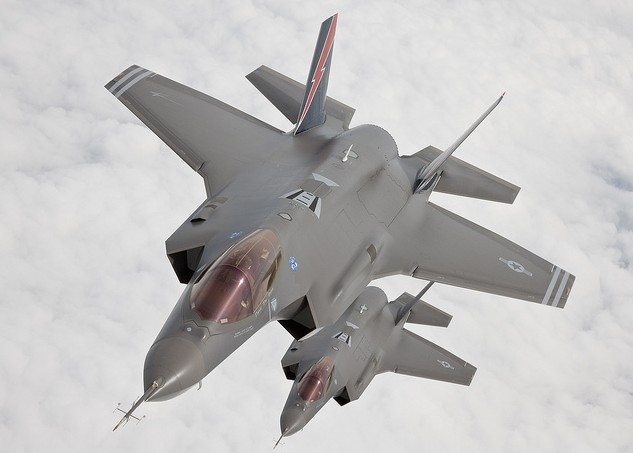Improvised explosive devices are the weapons of choice for insurgents, and representatives from Europe and the Middle East participated in the U.S. Army in Europe and the Joint Multinational Training Command’s Coalition Counter-IED Training Conference, March 1-3, at the Hohenfels Training Area in Hohenfels, Germany.
The three-day conference, sponsored by the Badger Team, a specialized training team that enhances the already realistic training environment at Hohenfels Training Area by injecting current, real-world experiences and lessons-learned into Mission Rehearsal Exercises and training events brought the coalition partners together to learn Counter-IED, or C-IED, techniques and procedures, enable cross-talk between nations, and promote an understanding of the current C-IED operating environment.
“It was an opportunity for our partner nations to share tactics, techniques and procedures. Everybody has got a different perspective,” said Lt. Col. Michael D. Oliver, senior Counter-IED Trainer. “We’re going to work together. It directly affects Soldiers, and it’s about getting all our partners to move beyond the focus of limitations toward building capacity so they can train themselves.”
The Badger team was stood-up to coordinate and synchronize C-IED training at JMTC, he said.
About 30 percent of the forces that support the International Security Assistance Force in Afghanistan are coalition forces, and of those more than 80 percent are from the U.S. European Command’s area of responsibility.
In March, U.S. Secretary of Defense Robert M. Gates urged combatant commanders to develop concrete actions to assist coalition partners and enhance their Counter-IED capabilities in the areas of equipment, training and technical expertise, and the Badger Team was just one of the initiatives to support the directive.
Members of the Badger team were selected based on Military Occupational Specialty, deployment history and special skills. For example, a member serving on the Defeat-the-Device team would have specialized experience working with route clearance equipment.
“We try to find it before it explodes,” said Sgt. 1st Class Paul C. Burk, lead for the Defeat-the-Device Team. “We want Soldiers to know an IED can be anywhere. We teach them to think like the enemy.”
The Soldier learns to collect and preserve evidence, identify and exploit the enemy’s vulnerabilities, and maintain an offensive posture, said Burk.
Gathering evidence and performing forensics on the IEDs means U.S. and multinational forces can trace the source of the IED to a particular bomb-maker or organization.
“It’s about saving lives. That’s the bottom line,” said Staff Sgt. Gus Hurtado, Defeat-the-Device trainer. “We would prefer to defeat the device before there is a blast.”
Units have to collect evidence and perform forensic investigations to understand the signature of the IED bomb makers, which is significant to the IED fight, said Hurtado.
“We looked for a senior enlisted engineer guy that has either been to Iraq or Afghanistan or both,” said Sgt. Major Martin S. Celestine, senior enlisted advisor to the commander of the Badger Team. “Then we have a certification process to keep the guy current because we know things change every day in Afghanistan. In our selection criteria we looked for senior leaders who has served in Iraq and Afghanistan or a combination of both.”
The Badger team is organized around the three Joint Improvised Explosive Device Defeat Organization, known as JIEDDO, pillars: Attack-the-Network, Defeat-the-Device, and Train-the-Force that support the current operational environment in Afghanistan. The training is also conducted to support each of those same efforts.
“The Train-the-Force team goes to other countries and trains the multinational to train their forces at home station, said Sgt. 1st Class Daniel A. Barker, Badger Team trainer. “We train what they need based on what they have.”
Barker said it is a challenge working with multinationals because resources vary from country to country.
In 2010, Joint Multinational Training Command trained more than 4,000 U.S. and multinational Soldiers as part of brigade rotations. The Joint Multinational Training Command implemented a multinational Defeat-the-Device Route Clearance Patrol course in November, while also standing up the Badger C-IED Training Team.
“A unique aspect of the JMTC’s U.S. and NATO training rotations is the participation of coalition forces, which further enhances the training environment,” said Celestine. “We are Counter-IED specific, and this is the first time JMTC has had this capability. We provide individual and collective training and train trainers, so they can go back and train their own units.”
Celestine said, it doesn’t matter what country students come from. Both U.S. and multinational forces learn to identify the same visual indicators of an IED and how to react to a suspected IED.
“This is in concert with NATO’s initiative to establish a common standard,” said Marine Maj. Don Meek, of NATO in Brunssum in the Netherlands. “JMTC is one of many organizations trying to contribute.”











